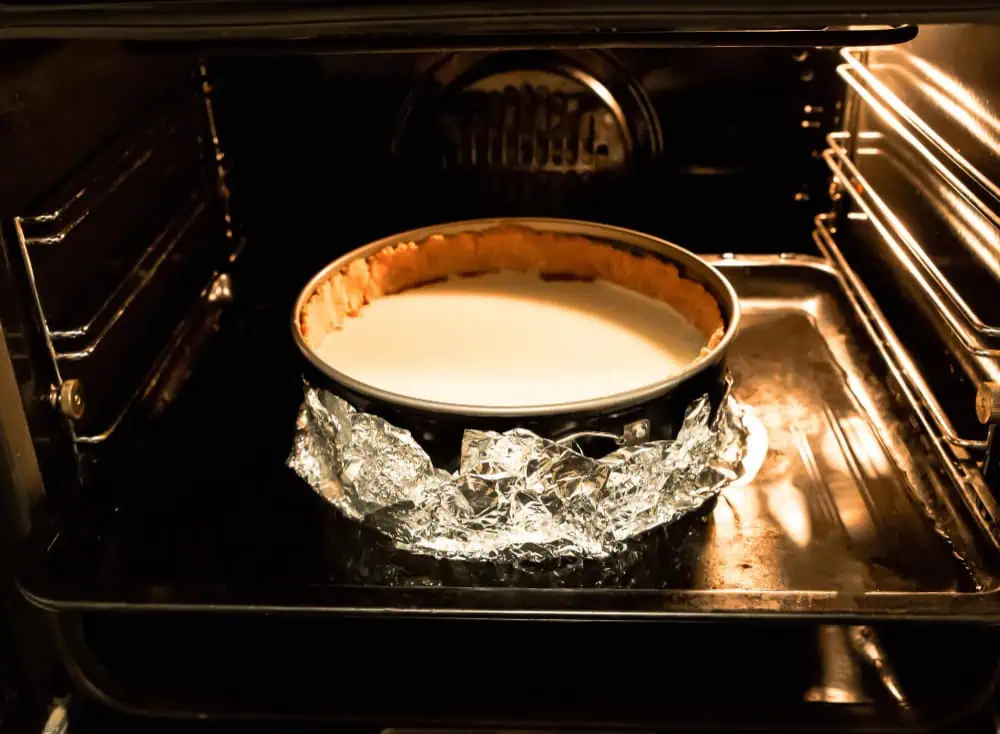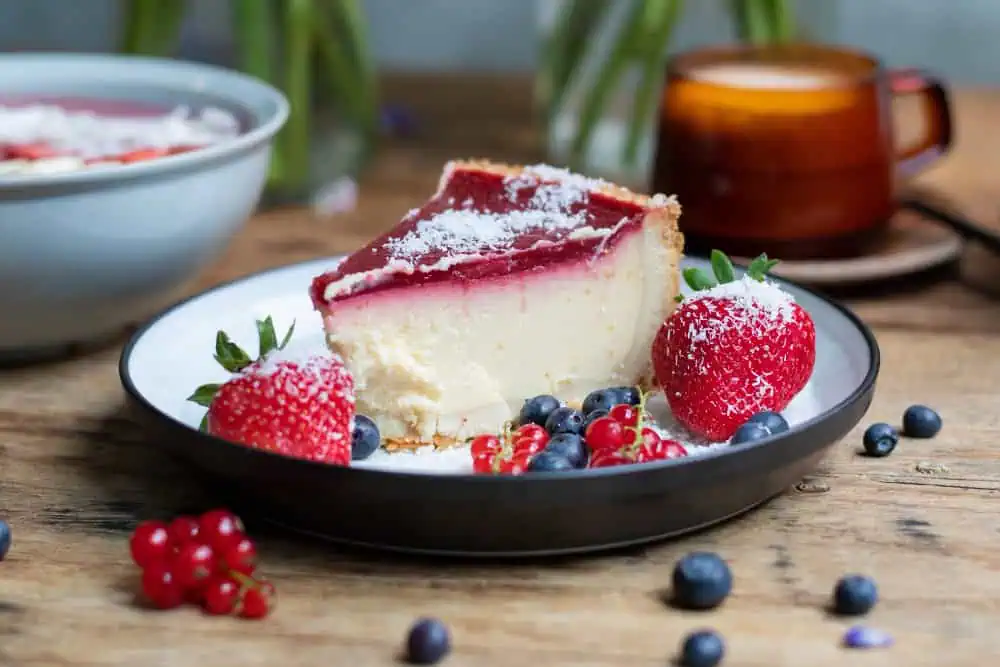If you’ve ever tried your hand at baking a cheesecake, you’ve likely come across the term water bath. But what exactly is a water bath, and why is it so important when making cheesecake? In this comprehensive guide, we’ll dive deep into everything you need to know about using a water bath for cheesecake, including its purpose, how to set it up, and tips for success. Whether you’re a beginner or a seasoned baker, this article will answer all your questions and help you achieve that perfect, creamy cheesecake every time.
If you’re interested in exploring different cheesecake styles, check out our guide on the three types of cheesecake.
What Is a Water Bath?
A water bath, also known as a bain-marie, is a baking technique where a pan of water is placed in the oven to create a moist and gentle cooking environment. When making cheesecake, the springform pan containing the cheesecake batter is placed inside a larger pan filled with hot water. This method ensures even baking and prevents the cheesecake from cracking or drying out.
The water bath works by regulating the temperature around the cheesecake, allowing it to bake slowly and evenly. Cheesecakes are delicate custard-based desserts, and the moist heat from the water bath helps maintain their creamy texture while avoiding overcooking.
Why Use a Water Bath for Cheesecake?
Using a water bath when making cheesecake is essential for several reasons:
- Prevents Cracks: Cheesecakes are prone to cracking due to sudden temperature changes or overbaking. The steam from the water bath keeps the surface moist and prevents cracks from forming.
- Even Baking: The water bath ensures that the cheesecake bakes evenly, avoiding overcooked edges and an undercooked center.
- Creamy Texture: The gentle heat from the water bath helps the cheesecake set slowly, resulting in a smooth, creamy texture. For more tips on achieving perfect desserts, discover the secrets of creating the perfect creme brulee.
- Avoids Browning: Without a water bath, the top of the cheesecake may brown too quickly, which can affect its appearance and taste.
How to Set Up a Water Bath for Cheesecake
Setting up a water bath may seem intimidating at first, but it’s actually quite simple. Follow these steps to create the perfect water bath for your cheesecake:
1. Gather Your Tools
You’ll need the following items:
- A springform pan for your cheesecake batter.
- A larger roasting pan or baking dish to hold the water.
- Aluminum foil or a silicone wrap to prevent water from leaking into the springform pan.
- Hot water (boiled or very warm).
2. Prepare the Springform Pan
Since springform pans are not watertight, you’ll need to protect your cheesecake from water seeping in:
- Wrap the bottom and sides of the springform pan tightly with aluminum foil. Use at least two layers to ensure no water gets through.
- Alternatively, use a silicone wrap designed for springform pans, which provides a watertight seal.
3. Place the Cheesecake in the Roasting Pan
- Place the prepared springform pan with the cheesecake batter into the larger roasting pan or baking dish.
4. Add Hot Water
- Carefully pour hot water into the roasting pan until it reaches about halfway up the sides of the springform pan. Be cautious not to splash water onto the cheesecake.
5. Bake the Cheesecake
- Place the entire setup in the oven and bake according to your recipe’s instructions. The water bath will create a steamy environment, ensuring your cheesecake bakes evenly.
Tips for a Successful Water Bath
To ensure your cheesecake turns out perfectly, keep these tips in mind:
- Use Boiling Water: Start with boiling or very hot water to create steam quickly in the oven.
- Check for Leaks: Double-check that your springform pan is tightly wrapped to prevent water from seeping in.
- Don’t Overfill the Pan: Only fill the roasting pan halfway with water to avoid spills when transferring it to the oven.
- Monitor the Water Level: If you’re baking a cheesecake for a long time, check the water level periodically and add more hot water if needed.
- Cool Gradually: After baking, let the cheesecake cool in the oven with the door slightly ajar to prevent sudden temperature changes that can cause cracks.
For more insights on ingredients that affect cheesecake texture, read our article on whether sour cream or whipping cream is better for cheesecake.
Common Mistakes to Avoid When Using a Water Bath
Even experienced bakers can run into issues when using a water bath. Here are some common mistakes to avoid:
- Skipping the Foil Wrap: If you don’t wrap your springform pan properly, water can seep in and ruin your cheesecake.
- Using Cold Water: Starting with cold water delays the steaming process and can affect the baking time.
- Overfilling the Roasting Pan: Too much water can make it difficult to handle the pan and may cause spills.
- Not Preheating the Oven: Always preheat your oven to ensure consistent baking temperatures.
- Removing the Cheesecake Too Soon: Let the cheesecake cool gradually to avoid cracks caused by sudden temperature changes.

Alternatives to a Traditional Water Bath
If you’re hesitant to use a traditional water bath, there are a few alternatives you can try:
- Place a Pan of Water on the Oven Rack Below: Instead of placing the cheesecake in a water bath, you can place a pan of hot water on the rack below the cheesecake. This creates a steamy environment without the risk of water seeping into the cheesecake.
- Use a Silicone Water Bath Pan: Some silicone pans are designed to hold water and fit snugly around a springform pan, eliminating the need for foil wrapping.
- Bake at a Lower Temperature: While not as effective as a water bath, baking at a lower temperature can help reduce the risk of cracks.
FAQs About Water Baths for Cheesecake
1. What happens if I don’t use a water bath for cheesecake?
Without a water bath, your cheesecake is more likely to crack, bake unevenly, or develop a dry texture. The water bath helps create a moist and gentle baking environment, which is essential for achieving a creamy, smooth cheesecake.
2. Can I use a regular cake pan instead of a springform pan?
While a springform pan is ideal for cheesecakes, you can use a regular cake pan if needed. However, it may be more challenging to remove the cheesecake without damaging it.
3. How do I prevent water from leaking into my cheesecake?
To prevent leaks, wrap the springform pan tightly with multiple layers of aluminum foil or use a silicone wrap. Double-check for any gaps or tears in the foil before placing the pan in the water bath.
4. Do all cheesecakes require a water bath?
Not all cheesecakes require a water bath. Some recipes, like no-bake cheesecakes, don’t involve baking at all. However, for baked cheesecakes, a water bath is highly recommended for the best results.
5. Can I reuse the water from the water bath?
It’s best to discard the water after baking, as it may contain grease or residue from the oven. Always start with fresh water for each bake.
Troubleshooting Water Bath Issues
Even with careful preparation, you may encounter some challenges when using a water bath. Here’s how to troubleshoot common problems:
- Water Leaked Into the Cheesecake: If water seeps into the cheesecake, it’s likely due to insufficient wrapping. Next time, use more layers of foil or switch to a silicone wrap.
- Cheesecake Still Cracked: Cracks can occur if the cheesecake is overbaked or cooled too quickly. Use an oven thermometer to ensure accurate temperatures and cool the cheesecake gradually.
- Edges Overcooked: If the edges of your cheesecake are overcooked, try reducing the oven temperature slightly or baking for a shorter time.
Related Baking Techniques
If you’re interested in mastering other baking techniques, here are a few that pair well with using a water bath:
- Blind Baking: A method used for pre-baking pie crusts to prevent sogginess. This technique is often used in tarts and pies where a crisp crust is desired.
- Double Boiler: Similar to a water bath, a double boiler is used for gently melting chocolate or cooking custards. This method is perfect for delicate ingredients that can easily scorch.
- Steam Baking: A technique that uses steam to create moist baked goods, such as bread or cakes. This method is particularly useful for achieving a crusty exterior on artisan breads.
The Science Behind the Water Bath
Understanding the science behind the water bath can enhance your baking skills. Here’s a closer look at how it works:
- Temperature Regulation: The water bath helps maintain a consistent temperature around the cheesecake. Water boils at 212°F (100°C), which means that the temperature of the cheesecake will not exceed this point, preventing overcooking.
- Moisture Retention: The steam generated from the boiling water keeps the air in the oven humid. This humidity is crucial for preventing the cheesecake from drying out and helps maintain its creamy texture.
- Gentle Cooking: The water bath provides a buffer against direct heat from the oven, allowing the cheesecake to cook gently. This slow cooking process is essential for achieving the desired custard-like consistency.
Popular Cheesecake Variations That Benefit from a Water Bath
While traditional New York-style cheesecake is a classic, many variations can benefit from the water bath technique. Here are a few popular options:
1. Chocolate Cheesecake
Rich and decadent, chocolate cheesecake is a favorite among chocolate lovers. The water bath helps ensure that the chocolate melts smoothly and integrates well into the batter, resulting in a creamy texture.
2. Fruit-Infused Cheesecake
Cheesecakes infused with fruit flavors, such as raspberry, lemon, or pumpkin, can also benefit from a water bath. The moisture helps preserve the vibrant flavors and prevents the fruit from caramelizing or burning during baking.
3. Ricotta Cheesecake
Ricotta cheesecake is lighter and fluffier than traditional cheesecakes. The water bath helps maintain the delicate texture of the ricotta, ensuring a smooth and creamy dessert.
4. Savory Cheesecake
Savory cheesecakes, such as those made with goat cheese or herbs, can also be baked using a water bath. The gentle heat helps the flavors meld together without overcooking the cheese.
To learn more about the differences between New York and classic cheesecakes, check out our detailed comparison.
Creative Serving Suggestions for Cheesecake
Once you’ve mastered the art of baking cheesecake with a water bath, it’s time to get creative with your presentation and serving. Here are some ideas to elevate your cheesecake experience:
- Garnish with Fresh Fruit: Top your cheesecake with fresh berries, sliced fruits, or a fruit compote for a burst of color and flavor.
- Drizzle with Chocolate or Caramel Sauce: A drizzle of chocolate or caramel sauce adds a decadent touch to your cheesecake. Consider using a squeeze bottle for a beautiful presentation.
- Serve with Whipped Cream: A dollop of freshly whipped cream can enhance the richness of the cheesecake and add a light, airy texture.
- Add a Crunchy Topping: Consider adding a layer of crushed cookies, nuts, or granola on top of your cheesecake for added texture and flavor.
- Pair with Ice Cream: Serve slices of cheesecake alongside a scoop of ice cream for a delightful dessert combination.

Final Thoughts on Using a Water Bath for Cheesecake
A water bath is a simple yet essential technique for baking the perfect cheesecake. By creating a moist and gentle baking environment, the water bath ensures your cheesecake bakes evenly, stays crack-free, and achieves that signature creamy texture. While it may take a little extra effort to set up, the results are well worth it.
Whether you’re making a classic New York-style cheesecake or experimenting with unique flavors, using a water bath will elevate your baking game and impress your family and friends. So next time you’re in the kitchen, don’t skip the water bath—your cheesecake will thank you!
Additional FAQs
1. Can I bake other desserts using a water bath?
Yes! A water bath is commonly used for other custard-based desserts like flan, crème brûlée, and bread pudding. It’s a versatile technique that ensures smooth and creamy results.
2. What’s the best way to store a cheesecake?
After baking, let the cheesecake cool completely, then refrigerate it for at least 4 hours (or overnight) before serving. Store it in an airtight container to keep it fresh.
3. Can I freeze a cheesecake?
Yes, cheesecakes freeze well. Wrap the cooled cheesecake tightly in plastic wrap and aluminum foil, then freeze for up to 3 months. Thaw in the refrigerator before serving.
4. How long should I bake my cheesecake in a water bath?
Baking times can vary depending on the recipe and oven temperature. Generally, cheesecakes take about 50 to 70 minutes in a water bath. Check for doneness by gently shaking the pan; the center should be slightly jiggly but not liquid.
5. What should I do if my cheesecake is overcooked?
If your cheesecake is overcooked, it may have a grainy texture. To salvage it, consider blending it with some cream cheese or sour cream to restore creaminess. For future bakes, monitor the baking time closely and use a thermometer to check the internal temperature.
By following these tips and techniques, you’ll be well on your way to mastering the art of baking cheesecakes with a water bath. Happy baking!

